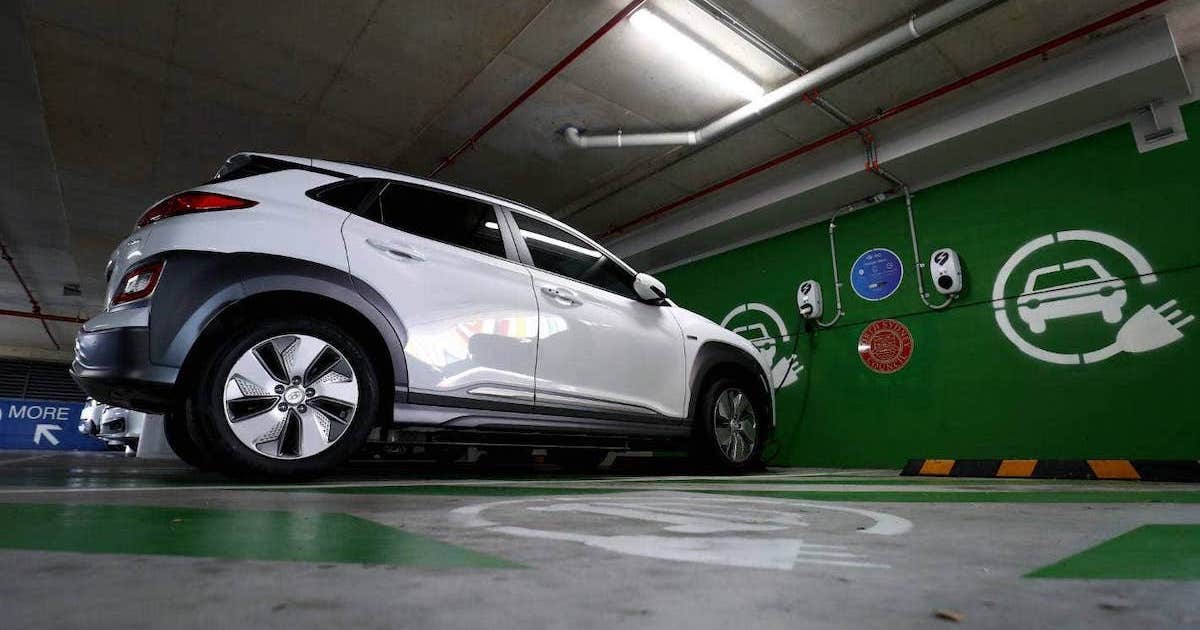OCBC announced yesterday (August 18) a collaborative project with the National University of Singapore (NUS) to conduct research on the decarbonisation of urban travel. This partnership encompasses multiple research studies, with the first focused on electric vehicles (EVs).
At the launch event yesterday, OCBC hosted a panel discussion, in which sustainability and EV experts delved further into the EV concerns among consumers in Singapore.
The panellists consisted of Jessica Cheam, founder and Managing Director of Eco-Business; Associate Professor Alberto Salvo, Deputy Head for Research, NUS Department of Economics; Goh Chee Kiong, CEO of Charge+; and Pamela Low, Business Development Manager of Strivy.
Addressing the EV presence in Singapore

Cheam kicked off the panel discussion by addressing the elephant in the room — what can be done to drive public EV adoption — which is a key driver behind the launch of the OCBC and NUS partnership.
Consumers’ concerns include cost and convenience, lack of EV charging stations, and concerns on speed. Locally, the adoption of EVs also include limited legal choices, namely charging infrastructure, higher road taxes, and higher legal upfront costs.
Consumers have very practical considerations, so how do we respond with better policy making? How do we respond with better business products to encourage greener behaviour? [Despite the concerns], globally, we are seeing a record number of EV take-ups. So, the question again is, how quickly and how accelerated can this happen?
– Jessica Cheam, founder and Managing Director of Eco-Business
Based on an EV timeline, Cheam explains how the EV development over the years has mainly been a waiting game, with pockets of pilots. Only in 2019, during Prime Minister Lee’s National Day Rally speech, was climate change truly identified as an existential issue for Singapore.

“Only then did we really see this policy momentum and a lot of initiatives coming up to encourage us to adopt this form of transportation,” she continued.
The research partnership presents a window of opportunity to a better understanding of the factors that might influence current owners of petrol vehicles to make the switch to EVs.
What comes first: push for EV adoption or charging infrastructure?
Charge+‘s Goh builds on a previous point on how EV and the topic of greener living has grown over the years.

Prior to founding Charge+, Goh served a number of years in the Economic Development Board (EDB), looking after the growth of sustainability and urban solution sector. Whilst pitching solar energy to agencies, he was turned down and dismissed for “wasting time and resources”.
Yet, in the last two years, Singapore made the big decision to phase out conventional vehicles by 2040.
After 2040, you’ll have to take your grandchildren to the museum to see an internal combustion engine (ICE) vehicle. They’ll ask, why would you want to have a vehicle with a tailpipe during your era? Because by then, it’ll become common sense that a battery-electric configuration is the optimum model for land transport.
– Goh Chee Kiong, CEO of Charge+
To most Singaporeans, 2040 might be a long way ahead. However, with Certificate of Entitlement (COE) granting owners legal rights to register and drive their vehicle in Singapore for a period of only 10 years, the EV change could come much faster.
Acknowledging that Singapore’s small size makes it an ideal candidate for rapid EV adoption, the overall dilemma is a “chicken-and-egg” conundrum of which comes first: the push for EV adoption, or the building of EV infrastructure.
Feasibility of EV chargers across Singapore
Charge+ is a key player in the proliferation of EV charging, and is active in the condominium market.
“Until they (residents) see an EV charging station appearing at their doorstep, they’re very hesitant about buying an EV,” Goh says.
One of the key concerns mentioned by Cheam is the consumers’ worry about the lack of charging infrastructure. Having to rely on public chargers at shopping malls versus overnight charging within their Housing Development Board (HDB) or condominium compound, consumers would rather opt for the latter.
Presently, Charge+ is part of an ongoing tender, deploying up to 24,000 EV charging points across HDB carparks in Singapore, with a hope that EV charging points will appear in said locations over the next two years.
Goh added that there will be some rotation when it comes to charging EVs. “We’re so used to charging our phones every 12 hours every day, but for EVs, we need to develop that social habit where it only needs to be charged once every five days.”
The mindset change lies with drivers who need to get used to a “more than five minute” experience — the fastest charge for an EV is 30 to 45 minutes.
Goh also raises the issue of drivers hogging the charging points, leaving the car conveniently for more than the stipulated charge time, thus depriving others from using the lot.
To mitigate this, Charge+ offers software techniques to schedule charging times and ensure equitable usage of charging points. Charge+ also imposes a hogging fee, applicable after a certain grace period. For instance, after an hour, the user will have to pay a penalty fee of S$2 for every 15 minutes.
“That will change the hogging mindset because Singaporeans hate waiting, but they also hate fines,” explained Goh.
Both HDB and the Land Transport Authority (LTA) are also in the midst of a planning parameter to meet the target of installing 60,000 EV charging points by 2030.
For every HDB carpark, 15 per cent of the lots will be equipped with EV charging stations. This was decided based on the ratio of one EV charging point to four or five users.
Greenwashing: A barrier for EV adoption?
In contrast to Goh’s statement on the need to build EV infrastructure, Low, who advocates for a cleaner environment, commonly experiences the question “does the clean-up solve anything?” from businesses, consumers, and even policymakers.
Clean-up is not the solution. [Instead], it’s a way to see what the problem is. Globally, we can see much stronger policies for recycling etcetera, and it starts from the policy basis or advocacy. Technology and companies are incentivised, hence when policies are implemented, there are favourable responses.
– Pamela Low, Business Development Manager of Strivy
Professor Salvo seconds this, labelling it a conversion of awareness to action. “Increased consumer awareness of how their choices will impact the environment can then be supplemented with information, leading to an increased accountability to their actions,” he adds.
He uses the carbon footprint of food systems as an example, with red meat regurgitating the most greenhouse gas emissions, as compared to white meat such as chicken.

It’s not about banning red meat entirely. It’s about educating the consumer, and giving them a choice to go for the greener product if it’s not inconvenient. This in turn will contribute to the transition.
– Associate Professor Alberto Salvo, Deputy Head for Research, NUS Department of Economics
However, in the midst of companies trying to advocate for a greener future, consumers might be discouraged by misinformation as well as greenwashing.
“I see greenwashing as a glass half full. Many companies around the world, including reputable multinational companies, over-amplify their green credentials and their achievements for sustainability,” says Goh.
“I personally don’t think telling companies to ‘Save the Earth’ is going to drive them to do so, but companies are pragmatic. As long as you focus on what makes sense to companies, there’ll be more change happening in the corporate world. Greenwashing is tough, but we have to keep focusing on the motivations for why they’re doing it.”
Some of the motivations include customers’ and employees’ demand, especially among young adults who look for a purposeful job and companies that take sustainability seriously.
He also adds that the government should encourage and amplify positive behaviour. If companies do well and do good, they should be recognised for it.
So, is EV adoption really greener?
“When you have to climb the mountain, it’s a lot of work. But what’s the best way to climb?” questions Goh, adding that there will inevitably be destruction to the ecosystem.
However, he assures that EV battery makers and EV dealers are mindful, and enforcing a good supply chain system such as meeting certain standards during the mining process. The argument still stands that EV benefits the environment on a larger scale.
Goh also goes on to break down the differences between ICE and EVs. With every ICE conversion to an EV, there is a 50 per cent carbon emissions reduction — this is sufficient, especially since the land transport sector contributes 15 per cent to Singapore’s emissions profile.
Converting every heavy vehicle, including buses, knock off seven percent points from Singapore’s emissions profile in comparison to solar panels that only help by four to five per cent.
ICEs are energy inefficient. Every unit of energy-petrol or diesel put in your tank gives you only 25 per cent of mechanical motion. 75 per cent is lost because of heat. On the other hand, battery vehicles have 80 per cent energy retention, with only 20 per cent energy lost.
– Goh Chee Kiong, CEO of Charge+
Taking into account the energy efficiency of Singapore’s power plants — which are heavily reliant on natural gas power plants that run at 60 per cent energy efficiency — and the total lifecycle emissions inclusive of mining, transport of batteries and all supply chains, EVs are still far more environmentally friendly than ICEs.
Although there is a downside to the proliferation of EVs with certain elements (such as cobalt) facing exhaustion, Cheam clarifies that a lot of research and development (R&D) is already in progress for innovations around the circular economy.
The lithium and cobalt industries are in the works of trying to legislate laws where manufacturers have to retrieve the batteries used in EVs, and then put these minerals back into the economy, making sure there is no waste.
Professor Salvo also added on how businesses need to think not only about bringing the products into service, but what happens at the end of its life.
Likening the EV adoption and a greener future to his carbon footprint metaphor, he went on to paint a picture to lend a clearer perspective.
“Finishing 100 grams of beef is equivalent to 10km on a petrol car, which is then equivalent to a tree growing a whole week and working to reduce carbon dioxide. Instead of beef, go with chicken. Instead of 3kg of carbon dioxide, you’re looking at a fifth of that.”
“So, instead of driving a petrol car, get an EV, then you’re dividing the numbers by two. There are choices we can make. It’s not [immediately] solving the problem, but if every one of us is more aware and more accountable, and responding to the social signals, they add up.”
Cheam concluded by further reiterating how as a society, it’s important to be well-informed in order to support the right policies, the right businesses, and finally emerge with a consensus in which everyone can say: “This is the way forward, and this is what we support in order to get to a net-zero economy.”
Featured Image Credit: Brendon Thorne via Getty Images








